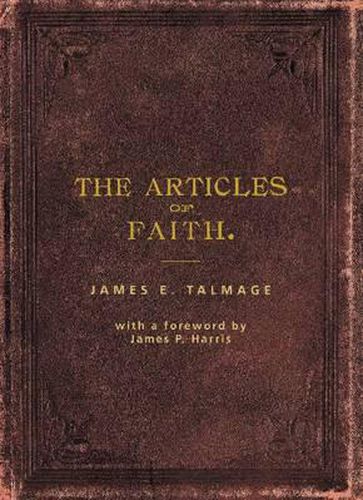Readings Newsletter
Become a Readings Member to make your shopping experience even easier.
Sign in or sign up for free!
You’re not far away from qualifying for FREE standard shipping within Australia
You’ve qualified for FREE standard shipping within Australia
The cart is loading…






Twenty-nine-year-old geologist and college president James E. Talmage noted in his journal in 1891: Today I had an interview with the First Presidency of the Church another appointment for an interview was set for Monday next. From these two meetings came a commission to write twenty-four lectures, twenty-two of which were ultimately delivered to college audiences, treating the basic tenets of LDS beliefs. The lectures were then published by the church asThe Articles of Faith, the only authorized, book-length explication of Mormon belief. The book proved to be one of several seminal treatises Talmage would write that would dominate the landscape of Mormon beliefs for a century.Talmage felt honored to write for the church and offeredThe Articles of Faith as a gift, waiving royalties. The first print run of 10,500 quickly sold out and has sold well to the present day.
Besides articulating well-established points of doctrine, The Articles of Faith also addresses controversies concerning eternal progress, the Holy Ghost, the kingdom of God, rebaptism, and unforgivable sins.
Accompanying this edition of The Articles of Faith an exact photomechanical reproduction of the first edition is another, albeit lesser-known work compiled by Talmage entitled Latter-day Revelation; it is a 1930 abridged version of the church s Doctrine and Covenants, apparently intended to replace the lengthier compilation. Latter-day Revelation was subsequently translated into several languages and was, for many years, the only version of the Doctrine and Covenants available in some countries. Yet, the English edition quietly disappeared soon after its release. In the preface to the present volume, Talmage scholar James P. Harris explains why and provides further context for Talmage s treatment of the Thirteen Articles of Faith.
$9.00 standard shipping within Australia
FREE standard shipping within Australia for orders over $100.00
Express & International shipping calculated at checkout
Twenty-nine-year-old geologist and college president James E. Talmage noted in his journal in 1891: Today I had an interview with the First Presidency of the Church another appointment for an interview was set for Monday next. From these two meetings came a commission to write twenty-four lectures, twenty-two of which were ultimately delivered to college audiences, treating the basic tenets of LDS beliefs. The lectures were then published by the church asThe Articles of Faith, the only authorized, book-length explication of Mormon belief. The book proved to be one of several seminal treatises Talmage would write that would dominate the landscape of Mormon beliefs for a century.Talmage felt honored to write for the church and offeredThe Articles of Faith as a gift, waiving royalties. The first print run of 10,500 quickly sold out and has sold well to the present day.
Besides articulating well-established points of doctrine, The Articles of Faith also addresses controversies concerning eternal progress, the Holy Ghost, the kingdom of God, rebaptism, and unforgivable sins.
Accompanying this edition of The Articles of Faith an exact photomechanical reproduction of the first edition is another, albeit lesser-known work compiled by Talmage entitled Latter-day Revelation; it is a 1930 abridged version of the church s Doctrine and Covenants, apparently intended to replace the lengthier compilation. Latter-day Revelation was subsequently translated into several languages and was, for many years, the only version of the Doctrine and Covenants available in some countries. Yet, the English edition quietly disappeared soon after its release. In the preface to the present volume, Talmage scholar James P. Harris explains why and provides further context for Talmage s treatment of the Thirteen Articles of Faith.